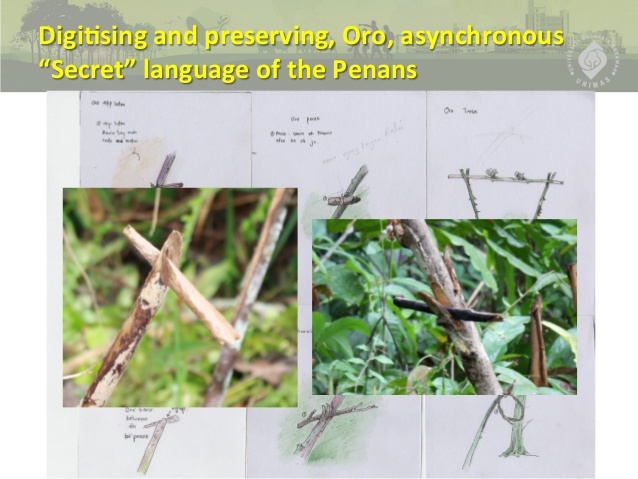Orality and Literacy
Ong’s desire to learn about the differences between oral and literary cultures may be considered deterministic as it categorizes and stereotypes people in to neatly fitted boxes. However, it does have relevance in terms of educators understanding the importance of the differences when teaching. In primarily Oral cultures – like the Penan indigenous people here on Borneo- the written word has little to no significance in the daily lives of the traditionally nomadic people.
An educator here commented to me on the fact that Penan children have great difficulty learning colours, as there are only two colours in the Penan languge- Red and Yellow. Also concepts of me and I don’t have relevance in a community based culture. However, there are over 40 different words to describe the word Sago which constitutes a major part of their diet. Rather than recognizing that standard education doesn’t fit the Penan- the Bruneian government continues to force Penan students to conform to print based learning while stereotyping them as “slow” and unintelligent.
Conversely, there is an ongoing project at University of Malaysia in Sarawak (UNIMAS), that is developing an app to teach a jungle sign language to Penan children. The jungle language predominantly made of different arrangements of leaves was very useful to the Penan while they were nomadic. However, recent logging and growth of Palm plantations have forced them to have a more settled existence, thus reducing the need to use the language and causing it to be on the brink of extinction as it is a place based language.
One of the things considered when creating the app was the honoring of the Penan sign language and oral culture. Therefore Indigenous Knowledge Management (IKM) systems were utilized by the researchers. By understanding the inherent difference in the communication practices of an Oral culture, the researchers of the software are transforming the approach of technology by teaching literacy through the oral tradition.
Educators in all settings should be aware of the implications of Oral versus text base teaching. To this day, we still put heavy emphasis on the power of rhetoric when candidates for Presidency or Prime Minister battle it out in debates, or in job interviews, where we need to prove ourselves worthy in a face to face interaction. We even teach small children how to read properly, focusing on punctuation, use of voice and intonation. So, although we have clearly moved to a more text based technologically driven learning culture, I argue that Ong’s work is still relevant if taken in context.
For an example of an amazing children’s author and story teller go to:
https://www.nfb.ca/film/christopher_please_clean_up_your_room
Here is an excellent article on IKM use in the Oroo app being created for the Penan.
introducing indegenous knowledge governance ino ICT based indegenous knowledge
Resources
Ong, W.J. (1982). Orality and Literacy: The technologizing of the word. New York, New York: Routledge.
Zaman, T., Yeo Wee, A., Kulathuramaiyer. N.(2013, Dec 9-10). Introducing Indigenous Knowledge governance in ICT-based Indigenous Knowledge Management System. Paper presented at IPID 8th International Annual Symposium.Cape Town, South Africa. Retrieved from


Just a quick comment now. This is not going to be all of what I’m feeling/thinking but thank you! As soon as I hear about the Penan people, I recall being in university at the University of Victoria in BC, Canada, and going to see/hear Wade Davis talk about the Penan people. He had five Penan men with him, which was amazing to me. But, I will write more about what you are saying. Thank you again for sharing this information and for your insights, and links. Pamela
I appreciate that this post was written with an educators point of view in mind. I agree that while Ong’s views are very black and white, he does have a point when it comes to orality and literacy in the educational realm. As a teacher of both high school and elementary level students, I find that the oral aspect of language is just as important as the literacy, and with the orality of literature, comes literacy. Both are sometimes interconnected. I appreciated the use of the story, read by a wonderful storyteller, which gives life to the characters using simply her voice. I am glad you recognized the importance of rhetoric in young students’ lives, without being able to effectively express themselves through spoken language, they may miss out on a plethora of career opportunities (job interviews, as you mentioned). I do believe that it is how ones speaks and their rhetoric that emphasizes their level of education.
However, this is a rigid point of view, if we are talking about education and intelligence, we are all aware that simply looking at literacy and orality to determine ones level of excellence is not sufficient. Of course as educators, we are aware that there are many different ways to look at intelligence, and it is our job to help them increase their oral and written output to ensure their intelligence is seen.